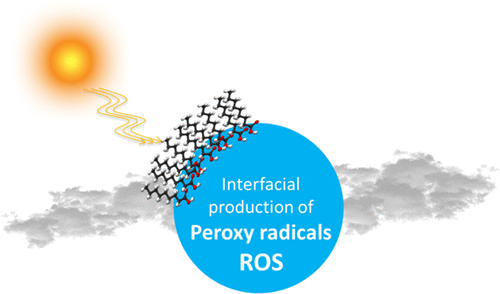当前位置:
X-MOL 学术
›
ACS Earth Space Chem.
›
论文详情
Our official English website, www.x-mol.net, welcomes your
feedback! (Note: you will need to create a separate account there.)
Production of Peroxy Radicals from the Photochemical Reaction of Fatty Acids at the Air–Water Interface
ACS Earth and Space Chemistry ( IF 2.9 ) Pub Date : 2020-07-20 , DOI: 10.1021/acsearthspacechem.0c00048 Nathalie Hayeck 1 , Ibrahim Mussa 1 , Sébastien Perrier 1 , Christian George 1
ACS Earth and Space Chemistry ( IF 2.9 ) Pub Date : 2020-07-20 , DOI: 10.1021/acsearthspacechem.0c00048 Nathalie Hayeck 1 , Ibrahim Mussa 1 , Sébastien Perrier 1 , Christian George 1
Affiliation

|
Peroxy radicals are known for their role in tropospheric photochemistry as intermediates in the oxidation of volatile organic compounds, leading to the formation of ozone and organic nitrate compounds. Similarly, in the particle phase, peroxy radicals, considered a type of reactive oxygen species (ROS), are also involved in many chemical transformations and produce a consequential fraction of aerosols with an impact on health. Here, we show that peroxy radicals are efficiently produced at the air–water interface upon irradiation of an organic film made of a simple fatty acid (i.e., nonanoic acid). This source of peroxy radicals was quantified as 0.27 ppbv after interfacial titration of the peroxy radicals by nitric oxide in a photochemical flow reactor. Using a combination of proton transfer reaction–time-of-flight–mass spectrometry (PTR–ToF–MS) and ultrahigh-performance liquid chromatography–heated electrospray ionization–high-resolution Orbitrap mass spectrometry (UHPLC–HESI–HR Orbitrap-MS), the products of this photochemistry were identified in the presence and absence of NO. The amount of peroxy radicals produced by this photochemistry was comparable to those measured in surface water or the ROS bounded to ambient secondary organic aerosols. Accordingly, the photochemistry of surfactants at the air–water interface might play a significant role in the health impact of organic aerosols.
中文翻译:

在空气-水界面处由脂肪酸的光化学反应产生过氧自由基
过氧自由基在对流层光化学中的作用是众所周知的,是挥发性有机化合物氧化的中间体,导致形成臭氧和有机硝酸盐化合物。同样,在颗粒相中,过氧自由基也被认为是一种活性氧(ROS),也参与许多化学转化,并产生相应比例的气溶胶,对健康产生影响。在这里,我们表明,辐照由简单脂肪酸(即壬酸)制成的有机膜后,会在空气-水界面上有效产生过氧自由基。在光化学流动反应器中通过一氧化氮界面滴定过氧自由基后,该过氧自由基的来源定量为0.27 ppbv。结合使用质子转移反应-飞行时间质谱(PTR-ToF-MS)和超高效液相色谱-加热电喷雾电离-高分辨率Orbitrap质谱(UHPLC-HESI-HR Orbitrap-MS) ,在有无NO的情况下鉴定出该光化学产物。通过这种光化学产生的过氧自由基的量与在地表水或与环境次级有机气溶胶结合的ROS中测得的量相当。因此,空气-水界面处的表面活性剂的光化学可能在有机气溶胶对健康的影响中起重要作用。在存在和不存在NO的情况下鉴定出这种光化学产物。通过这种光化学产生的过氧自由基的量与在地表水或与环境次级有机气溶胶结合的ROS中测得的量相当。因此,空气-水界面处的表面活性剂的光化学可能在有机气溶胶对健康的影响中起重要作用。在存在和不存在NO的情况下鉴定出这种光化学产物。通过这种光化学产生的过氧自由基的量与在地表水或与环境次级有机气溶胶结合的ROS中测得的量相当。因此,空气-水界面处表面活性剂的光化学作用可能在有机气溶胶对健康的影响中起重要作用。
更新日期:2020-08-20
中文翻译:

在空气-水界面处由脂肪酸的光化学反应产生过氧自由基
过氧自由基在对流层光化学中的作用是众所周知的,是挥发性有机化合物氧化的中间体,导致形成臭氧和有机硝酸盐化合物。同样,在颗粒相中,过氧自由基也被认为是一种活性氧(ROS),也参与许多化学转化,并产生相应比例的气溶胶,对健康产生影响。在这里,我们表明,辐照由简单脂肪酸(即壬酸)制成的有机膜后,会在空气-水界面上有效产生过氧自由基。在光化学流动反应器中通过一氧化氮界面滴定过氧自由基后,该过氧自由基的来源定量为0.27 ppbv。结合使用质子转移反应-飞行时间质谱(PTR-ToF-MS)和超高效液相色谱-加热电喷雾电离-高分辨率Orbitrap质谱(UHPLC-HESI-HR Orbitrap-MS) ,在有无NO的情况下鉴定出该光化学产物。通过这种光化学产生的过氧自由基的量与在地表水或与环境次级有机气溶胶结合的ROS中测得的量相当。因此,空气-水界面处的表面活性剂的光化学可能在有机气溶胶对健康的影响中起重要作用。在存在和不存在NO的情况下鉴定出这种光化学产物。通过这种光化学产生的过氧自由基的量与在地表水或与环境次级有机气溶胶结合的ROS中测得的量相当。因此,空气-水界面处的表面活性剂的光化学可能在有机气溶胶对健康的影响中起重要作用。在存在和不存在NO的情况下鉴定出这种光化学产物。通过这种光化学产生的过氧自由基的量与在地表水或与环境次级有机气溶胶结合的ROS中测得的量相当。因此,空气-水界面处表面活性剂的光化学作用可能在有机气溶胶对健康的影响中起重要作用。





















































 京公网安备 11010802027423号
京公网安备 11010802027423号